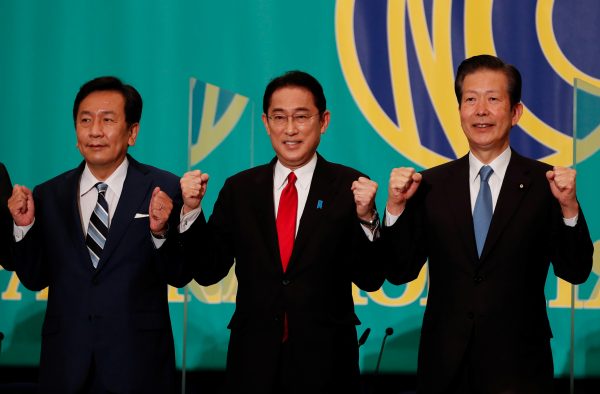While media attention has focussed on the implications of this partial rebuke to LDP rule, its oft-overlooked coalition partner, Komeito, increased its presence in the lower house from 29 to 32 seats. This small but significant electoral victory demonstrates that Komeito remains a powerful actor in Japanese politics.
Komeito is a unique religious-inspired political force in Japanese politics. The party has its origins as the political arm of Soka Gakkai, a new age Buddhist-revivalist sect known for its evangelist views. In 1970, the precursor to the present-day party distanced itself from Soka Gakkai to assuage criticism that it violated Japan’s strict post-war separation between church and state. Still, nearly all Komeito representatives are Soka Gakkai adherents, and allegations of control by the religious leader Daisaku Ikeda, continue to be levelled against Komeito. Today the party obtains most of its votes from its elderly and predominantly middle-class religious base, totalling around 13 per cent of the total voting population in the recent election.
Although only a fraction of the size of the LDP, the structure of the LDP-Komeito partnership suggests an interesting mode of power sharing. Under the coalition agreement, Komeito does not contest the vast majority of LDP seats and encourages Soka Gakkai members to vote for the ruling party. Adam P Liff estimates that in the 2014 elections, this agreement allowed almost a quarter of LDP candidates in single member districts to win their seats.
What does Komeito obtain in return for this cooperation? Despite its substantial potential influence, the LDP has reserved only one cabinet office, the Ministry of Land, Infrastructure, Transport and Tourism (MILT), for Komeito since 2012. The MILT is the second largest government employer after the Ministry of Defense and implements a third of Japan’s legal ordinances, making the post an important political prize. The MILT manages the nation’s massive transportation budget, which gives Komeito significant influence over local government.
But Komeito’s more consequential power is perhaps as an advocate for greater Japanese autonomy in foreign relations. On security, Komeito remains a rare force in the government advocating cooperation with China, is sceptical of increased defence spending and is a bulwark of anti-nuclear sentiment. Despite its alliance with the LDP, the party remains opposed to any meaningful amendment of Article 9 of Japan’s ‘pacifist’ constitution. Even the eventual compromise ‘reinterpretation’ of Article 9 in 2014 was opposed by Komeito leaders who ultimately watered down the proposed language of the bill.
Komeito is best understood as a traditionalist stop-gap that reigns in those in the LDP concerned with a rising a China and supportive of expanded security cooperation with Japan’s key treaty ally, the United States. As such, Komeito is a powerful partner for those factions within the LDP that would rather push minor reforms of the social welfare system than commit to a larger restructuring of the Japanese social contract.
A case and point is the victory of Kishida in the contentious LDP leadership race over popular Foreign Minister Taro Kono. Kishida has led the moderate Kochikai faction since 2012, one of the key factions supporting the preservation of Article 9. It is no coincidence that Kishida’s political mentor, Makoto Koga, was instrumental in bringing Komeito into coalition with the LDP.
In light of Komeito’s role in underpinning the current political alignment, advocates of reform will need to look beyond the LDP and its ageing pensioner voter base. There is room for common cause between reform-minded LDP factions and a collection of reformist parties like Yuriko Koike’s ‘Tokyoites First’ and the ‘Japan Innovation Party’ centred on Osaka. These regionalist parties are committed to a fundamental reconsideration of the Japanese economy, as well as an increasingly internationalist and muscular defence policy when compared to the present coalition of Komeito and LDP traditionalists.
Komeito’s strength in the recent elections has consolidated its authority within the coalition. If, as some predict, the LDP leadership devolves once again into a ‘revolving door’ of prime ministers, the party will become more dependent on Komeito to remain in power. Observers can expect Kishida to avoid difficult debates over security policy, expand social welfare spending, and consider only limited social reforms to satisfy Komeito.
Komeito’s influence over foreign policy suggests that Tokyo will be relatively restrained in its response to an increasingly assertive China. Any coalition government is likely to be critical of nuclear policy, sceptical of any large increases in defence spending, protective of Japan’s autonomy and supportive of maintaining diplomatic contact with Beijing. That bodes ill for those in Washington who expect Japan to contain a rising China, provided Komeito remains in the driving seat of Japanese political discourse.
Moez Hayat is a Fulbright Scholar and Visiting Researcher at the Academy of Brunei Studies, University of Brunei Darussalam.
Ryan Ashley is a PhD student in the Lyndon B Johnson School of Public Affairs at the University of Texas at Austin.

